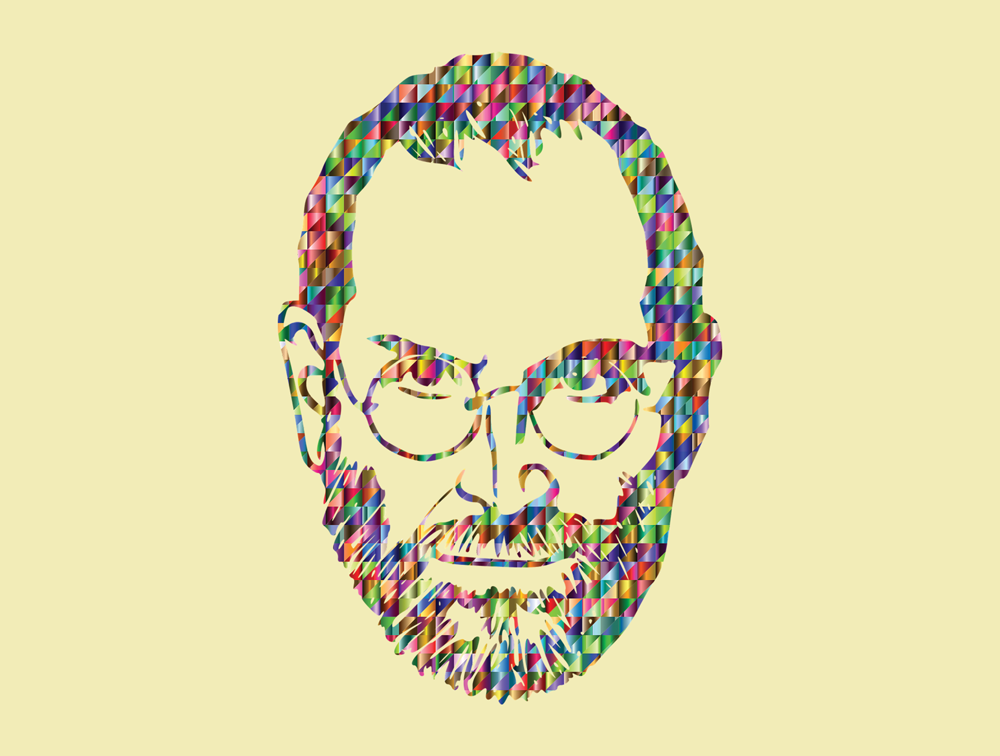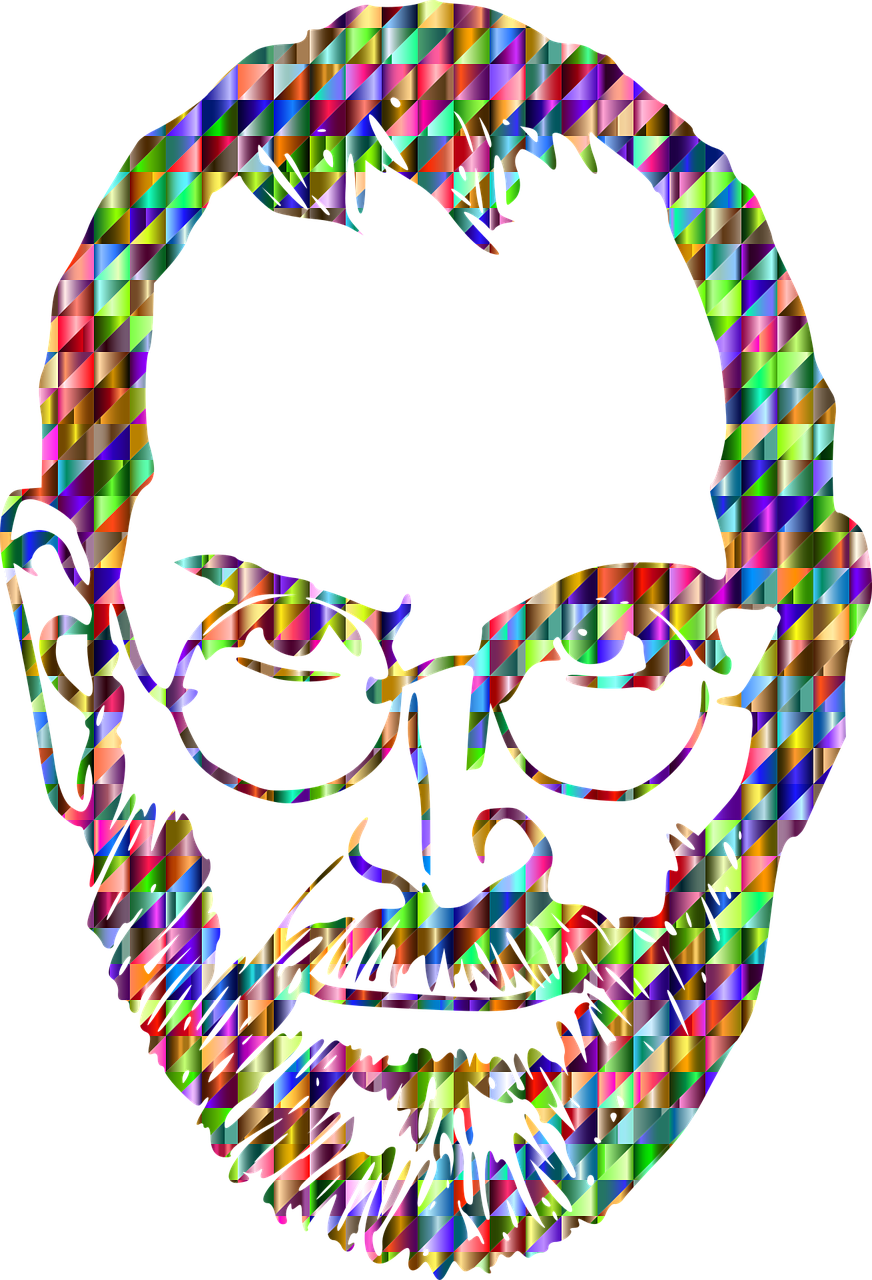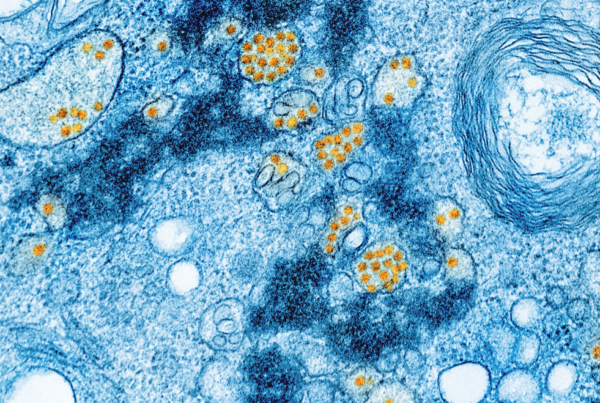
While the neurodiversity movement seeks to overcome stigma by celebrating neurological differences between people, the internet prefers to speculate about diagnoses for society’s most successful. What causes entrepreneurs to break the status quo, and could their neurodiversity be the key to success?
While the neurodiversity movement seeks to overcome stigma by celebrating neurological differences between people, the internet prefers to speculate about diagnoses for society’s most successful. What causes entrepreneurs to break the status quo, and could their neurodiversity be the key to success?

Image via Needpix.
‘Here’s to the crazy ones, the misfits, the rebels, the troublemakers, the round pegs in the square holes… the ones who see things differently; they’re not fond of rules… they push the human race forward, and while some may see them as the crazy ones, we see genius, because the ones who are crazy enough to think that they can change the world, are the ones who do.’
(Steve Jobs et al., 1997)
A venture capitalist once commented that he couldn’t work out whether I was crazy or a genius. Having lived my adult life at the extreme ends of both the wealth and mental health spectrums, it’s probably a bit of both. I’ve always felt my career success came despite mental health challenges. However, my recent diagnosis of bipolar II disorder has led me to appreciate the double-edged nature of my unusual neuropsychology. As Steve Jobs observed, it can pay to think differently. Fifteen years ago, I met a random psychologist on holiday who told me that entrepreneurship and schizophrenia run in the same families – as they do in mine. A more general link between entrepreneurship and psychopatholog was shown in a recent US study, which found that entrepreneurs were twice as likely to have been diagnosed with depression, three times as likely to suffer from addiction, six times as likely to have been diagnosed with ADHD and ten times more likely to be diagnosed with bipolar disorder (Freeman, Staudenmaier, Zisser, & Andresen, 2018). While the higher levels of stress experienced by entrepreneurs could support the conclusion that entrepreneurship can trigger depression and addiction, the same is not likely for ADHD and bipolar, which are more likely to be diagnosed before entrepreneurial endeavours.
Having written her thesis on entrepreneurship and schizophrenia, my holiday psychologist hypothesised that it was ‘knight’s move thinking’ that connects entrepreneurial insights and schizophrenic derailment. Knight’s move thinking describes a lateral reasoning process based on loose associations, leading to an unexpected conclusion that defies conventional logic. The name comes from chess, where a knight is the only piece able to move in a non-linear fashion, jumping further ahead. In Steve Job’s launch presentation for the iPhone, he placed great emphasis on how they had combined a music player, phone and web browser into a single device (Apple Inc, 2007). The result was certainly more than the sum of its parts, and it’s hard to imagine a world without smartphones nowadays. So knight’s move thinking allows entrepreneurs to identify cross-market trends and predict ‘the next big thing.’ However, while a big idea is a good starting point to inspire people to join a new entrepreneurial venture, product superiority plays a minor role in entrepreneurial outcomes (Roure & Keeley, 1990). More importantly, successful entrepreneurs need to be passionate, obsessive, optimistic, and hard working. For his book, The Hypomanic Edge, a prominent American psychologist asked a group of entrepreneurs whether a list of hypomanic symptoms were traits that they would associate with entrepreneurs (Gartner, 2005). Hypomania, as I only learned myself recently, is a highly-aroused mental state that is a milder form of mania. In combination with a prior instance of major depression, it is classified as bipolar II or in combination with a history of recurring mild depressions, as cyclothymia. The statements used to support entrepreneurial hypomania included items such as ‘he feels destined to change the world’ and ‘he often works on little sleep’, the only symptoms of hypomania that they did not agree as fitting with the stereotypical entrepreneur, were paranoia and sexual risk-taking. While Gartner’s research was more straw-poll than scientific, my own experience certainly supports it. Delusive self-belief and elevated mood were the norms for high-tech entrepreneurs and moderate risk taking anything but a hindrance from my perspective. Hence my hypomanic episodes went undetected, and my bipolar remained undiagnosed, 27 years after I first saw a psychiatrist. It wasn’t until I was prescribed antidepressants that my hypomania became problematic because SNRIs increase dopamine levels.
“Delusive self-belief and elevated mood were the norms for high-tech entrepreneurs”
My first hypomanic episode followed an episode of major depression precipitated by a traumatic life event in my late teens. Rather than attend my scheduled forty hours of boring old electronics lectures and lab-work, I put my hypomanic energies into creating a radio station for my first university instead. Recently, I came across a newspaper clipping from the day we launched, with me sitting in a studio with a duvet and joking about sleep deprivation. While starting a radio station was great for my mood, it did nothing for my exam results, and I decided to pursue my entrepreneurial ambitions rather than repeat the year. A few years later, having identified the need for accurate tracking of online marketing activity, I set up my first business (RedEye), and began writing software all day, every day. Punding (hyper-focus) is a common symptom of hypomania, defined as a single-minded focus on a specific goal or thought process, that leads to neglect of other areas of your life. This caused the breakdown of my relationship, which led to moderate depression. Struggling to maintain a relentless workload, I discovered recreational drugs, which enabled me to continue to work hard and play hard. Self-medication helped me to keep the business on its exponential growth curve for another year before I found myself in a psychiatric hospital, diagnosed with burn-out and participating in an addiction treatment program. While I was in hospital, my company landed our first six-figure order, but it took me a year to recover, by which time more competitors had arrived, the dot-com bubble had burst, and 9/11 had sent world stock markets into free fall. If your start-up is a rocket ship, then cash is the fuel that is required to power it into the stratosphere. We were in the final stages of closing a significant funding round before 9/11, but the potential investors backed out and raising capital became impossible. A few years later, with the business barely growing and my confidence still depleted, my investors bought me out, and I indulged my risk-taking hyper-focus into golf and supercars.
If I had been born a couple of decades later, then I suspect I would have been diagnosed with ADHD. The comorbidity between bipolar and ADHD has been well established, with a study of mood disorder outpatients finding that not only were twenty percent of bipolar patients diagnosed with ADHD but a mixed diagnosis also correlates with an earlier onset of bipolar if stressful life events occur (Perroud et al., 2014). As well as my neuropsychological predisposition for entrepreneurship, there were strong sociocultural influences in eighties Britain. Thatcher was a former shopkeeper who wanted to create a business environment to support a nation of entrepreneurs, with the likes of Richard Branson, who is open about his dyslexia and ADHD, becoming the new rockstars. Frustrated by my general disruptiveness, my physics teacher once exclaimed that I was a ‘perfect fodder (food) for Thatcher’s Britain.’ It was supposed to be an insult, but I took it as a compliment. While becoming an entrepreneur was somewhat in my DNA, there were strong environmental influences that led me from disrupting physics classes to disruptive technology.
When I dropped out of university, I did so knowing that I was in great company. Neither Bill Gates nor Steve Jobs completed their degrees. While it may not have applied in their case, almost a third of the entrepreneurs surveyed had been diagnosed with ADHD (Freeman et al., 2018). Entrepreneurs do tend to be easily distracted, poor time managers, restless, and have a tendency to finish your sentences for you. As for hyperactivity, that is an absolute prerequisite. However, given the extent to which hypomania is the Silicon Valley norm, and dysregulation of the dopamine system is implicated in both ADHD and bipolar, it would seem that most tech entrepreneurs are more dopamine than adrenalin junkies. Their brains are probably more dopamine-sensitive than is the norm, which creates a tendency for hypomania and predisposition for bipolar disorder and substance abuse (Ashok et al., 2017).
The dopaminergic pathways of the brain have been shown to play a significant role in goal-directed behaviour, attitude to risk, reversal learning, novelty seeking, and creative thinking (Dagher & Robins, 2009). Unfortunately, this was proven spectacularly by patients receiving medication for Parkinson’s disease, a disease that kills the dopamine-producing cells in a brain area known as the striatum. Since the eighties, Parkinson’s has been treated using dopamine-agonistic drugs, which activate the receptors that are usually stimulated by dopamine. However, for some patients, the medication turned out to have the unfortunate side-effect of transforming them into full-on high-rolling, drug taking, fast spending, and sexually promiscuous hypomaniacs (Dagher & Robins, 2009). The transformation could not have been more pronounced, given that people who develop Parkinson’s tend to have been quiet, risk-averse types beforehand (Sullivan et al., 2014). In scientific terms, there is a double dissociation: low dopamine leads to risk-averse introversion, high dopamine leads to hell-raising hedonism. The effect of dopamine on creativity can also be seen amongst overmedicated Parkinson’s patients. A study by Lhommee et al. (2014) found dramatic improvements in creativity amongst artists experiencing hypomanic side effects from their medication. Unfortunately, they also blew all their money on painting materials, painted on the walls and started hosting wild artistic gatherings at their family homes.
“My untreated bipolar built me up and broke me down, forcing me to pivot my career down a new path.”
There seems to be something abnormal about the relentless drive for success shown by the likes of Steve Jobs, Elon Musk, and Mark Zuckerberg. OCD, bipolar, or autism? The internet loves to speculate as to what diagnosis best fits their unusual genius and demeanour. From the outside, it would seem that their outcomes have been anything but negative, and to suggest anything other than a predisposition for a disorder would seem crazy in itself. They are outstanding products of our neurodiversity, for it seems that when times are hard, nature rolls the dopamine dice to produce the more extreme personalities that help society evolve. They may not have been the most agreeable people to get along with, but like Van Gogh, Newton and Churchill, we all enjoy the fruits of their passion. Neurodiversity leads to more extreme outcomes, and I’m glad that in my instance, I ended up in the boardroom and not the gutter, as so often seems to happen to the psychologically challenged.
Like most people diagnosed with bipolar II, I have lived for my hypomanic episodes, and they have proven, on the most part, highly profitable. While occasionally my behaviour has been inharmonious, disorderly and just plain crazy, it’s never struck me as symptomatic of a disorder. Indeed, one of the essential things for mood stability in bipolar disorder is sleep hygiene. My sleep became completely dysregulated after my second business went global, and I was almost permanently jetlagged. I struggled with my mood and made too many snap decisions, before an abrupt and acrimonious departure. My untreated bipolar built me up and broke me down, forcing me to pivot my career down a new path. But will the combination of technology and psychology prove a knight’s move for my career? Given the estimation that only one in ten thousand mobile apps will be financially successful within five years, my chances of success are low (Gartner Inc, 2014). I’d need to be crazy to be secretly fostering an idea of what I’d like to build once my studies are complete… <<
References
– [Image] Retrieved at June 10, 2019 from https://www.needpix.com/photo/897110/steve-jobs-apple-computers-ceo-man-male-people-persons-human/.
– Apple Inc. (2007). Steve Jobs Introducing The iPhone At MacWorld 2007. Retrieved at June 10, 2019 from https://www.youtube.com/watch?v=x7qPAY9JqE4&feature=youtu.be/.
– Ashok, A. H., Marques, T. R., Jauhar, S., Nour, M. M., Goodwin, G. M., Young, A. H., & Howes, O. D. (2017). The dopamine hypothesis of bipolar affective disorder: The state of the art and implications for treatment. Molecular Psychiatry, 22(5), 666–679.
– Dagher, A., & Robbins, T. W. (2009). Personality, Addiction, Dopamine: Insights from Parkinson’s Disease. Neuron, 61(4), 502–510.
– Freeman, M. A., Staudenmaier, P. J., Zisser, M. R., & Andresen, L. A. (2018). The prevalence and co-occurrence of psychiatric conditions among entrepreneurs and their families. Small Business Economics, 1-20.
– Gartner Inc. (2014, January 13). Gartner Says Less Than 0.01 Percent of Consumer Mobile Apps Will Be Considered a Financial Success by Their Developers Through 2018. Retrieved June 4, 2019, from https://www.gartner.com/en/newsroom/press-releases/2014-01-13-gartner-says-less-than-one-tenth-percent-of-consumer-mobile-apps-will-be-considered-a-financial-success-by-their-developers-through-2018/.
– Gartner, J. D. (2005). The Hypomanic Edge: The Link Between (A Little) Craziness and (A Lot of) Success in America. Simon & Schuster.
– Isaacson, W., & Jobs, S. (2011). Steve Jobs. Simon & Schuster.
Jobs, S., Siltanen , R., Chow, L., Chiat/Day Inc., & Apple Inc. (1997, November 28). Apple Think Different – Steve Jobs Narrated Version. Retrieved June 5, 2019, from https://www.youtube.com/watch?v=GEPhLqwKo6g/.
– Lhommee, E., Batir, A., Quesada, J.-L., Ardouin, C., Fraix, V., Seigneuret, E., … Krack, P. (2014). Dopamine and the Biology of Creativity: Lessons from Parkinson’s Disease. Frontiers in Neurology, 5, 55.
– Perroud, N., Cordera, P., Zimmermann, J., Michalopoulos, G., – Bancila, V., Prada, P., … Aubry, J.-M. (2014). Comorbidity between attention deficit hyperactivity disorder (ADHD) and bipolar disorder in a specialised mood disorders outpatient clinic. Journal of Affective Disorders, 168, 161–166.
– Roure, J. B., & Keeley, R. H. (1990). Predictors of success in new technology based ventures. Journal of Business Venturing, 5(4), 201–220.
– Sullivan, K. L., Mortimer, J. A., Wang, W., Zesiewicz, T. A., Brownlee, H. J., & Borenstein, A. R. (2014). Premorbid Personality and the Risk of Parkinson’s Disease. Journal of Neurology Research, 4(2–3), 81–87.
‘Here’s to the crazy ones, the misfits, the rebels, the troublemakers, the round pegs in the square holes… the ones who see things differently; they’re not fond of rules… they push the human race forward, and while some may see them as the crazy ones, we see genius, because the ones who are crazy enough to think that they can change the world, are the ones who do.’
(Steve Jobs et al., 1997)
A venture capitalist once commented that he couldn’t work out whether I was crazy or a genius. Having lived my adult life at the extreme ends of both the wealth and mental health spectrums, it’s probably a bit of both. I’ve always felt my career success came despite mental health challenges. However, my recent diagnosis of bipolar II disorder has led me to appreciate the double-edged nature of my unusual neuropsychology. As Steve Jobs observed, it can pay to think differently. Fifteen years ago, I met a random psychologist on holiday who told me that entrepreneurship and schizophrenia run in the same families – as they do in mine. A more general link between entrepreneurship and psychopatholog was shown in a recent US study, which found that entrepreneurs were twice as likely to have been diagnosed with depression, three times as likely to suffer from addiction, six times as likely to have been diagnosed with ADHD and ten times more likely to be diagnosed with bipolar disorder (Freeman, Staudenmaier, Zisser, & Andresen, 2018). While the higher levels of stress experienced by entrepreneurs could support the conclusion that entrepreneurship can trigger depression and addiction, the same is not likely for ADHD and bipolar, which are more likely to be diagnosed before entrepreneurial endeavours.
Having written her thesis on entrepreneurship and schizophrenia, my holiday psychologist hypothesised that it was ‘knight’s move thinking’ that connects entrepreneurial insights and schizophrenic derailment. Knight’s move thinking describes a lateral reasoning process based on loose associations, leading to an unexpected conclusion that defies conventional logic. The name comes from chess, where a knight is the only piece able to move in a non-linear fashion, jumping further ahead. In Steve Job’s launch presentation for the iPhone, he placed great emphasis on how they had combined a music player, phone and web browser into a single device (Apple Inc, 2007). The result was certainly more than the sum of its parts, and it’s hard to imagine a world without smartphones nowadays. So knight’s move thinking allows entrepreneurs to identify cross-market trends and predict ‘the next big thing.’ However, while a big idea is a good starting point to inspire people to join a new entrepreneurial venture, product superiority plays a minor role in entrepreneurial outcomes (Roure & Keeley, 1990). More importantly, successful entrepreneurs need to be passionate, obsessive, optimistic, and hard working. For his book, The Hypomanic Edge, a prominent American psychologist asked a group of entrepreneurs whether a list of hypomanic symptoms were traits that they would associate with entrepreneurs (Gartner, 2005). Hypomania, as I only learned myself recently, is a highly-aroused mental state that is a milder form of mania. In combination with a prior instance of major depression, it is classified as bipolar II or in combination with a history of recurring mild depressions, as cyclothymia. The statements used to support entrepreneurial hypomania included items such as ‘he feels destined to change the world’ and ‘he often works on little sleep’, the only symptoms of hypomania that they did not agree as fitting with the stereotypical entrepreneur, were paranoia and sexual risk-taking. While Gartner’s research was more straw-poll than scientific, my own experience certainly supports it. Delusive self-belief and elevated mood were the norms for high-tech entrepreneurs and moderate risk taking anything but a hindrance from my perspective. Hence my hypomanic episodes went undetected, and my bipolar remained undiagnosed, 27 years after I first saw a psychiatrist. It wasn’t until I was prescribed antidepressants that my hypomania became problematic because SNRIs increase dopamine levels.
“Delusive self-belief and elevated mood were the norms for high-tech entrepreneurs”
My first hypomanic episode followed an episode of major depression precipitated by a traumatic life event in my late teens. Rather than attend my scheduled forty hours of boring old electronics lectures and lab-work, I put my hypomanic energies into creating a radio station for my first university instead. Recently, I came across a newspaper clipping from the day we launched, with me sitting in a studio with a duvet and joking about sleep deprivation. While starting a radio station was great for my mood, it did nothing for my exam results, and I decided to pursue my entrepreneurial ambitions rather than repeat the year. A few years later, having identified the need for accurate tracking of online marketing activity, I set up my first business (RedEye), and began writing software all day, every day. Punding (hyper-focus) is a common symptom of hypomania, defined as a single-minded focus on a specific goal or thought process, that leads to neglect of other areas of your life. This caused the breakdown of my relationship, which led to moderate depression. Struggling to maintain a relentless workload, I discovered recreational drugs, which enabled me to continue to work hard and play hard. Self-medication helped me to keep the business on its exponential growth curve for another year before I found myself in a psychiatric hospital, diagnosed with burn-out and participating in an addiction treatment program. While I was in hospital, my company landed our first six-figure order, but it took me a year to recover, by which time more competitors had arrived, the dot-com bubble had burst, and 9/11 had sent world stock markets into free fall. If your start-up is a rocket ship, then cash is the fuel that is required to power it into the stratosphere. We were in the final stages of closing a significant funding round before 9/11, but the potential investors backed out and raising capital became impossible. A few years later, with the business barely growing and my confidence still depleted, my investors bought me out, and I indulged my risk-taking hyper-focus into golf and supercars.
If I had been born a couple of decades later, then I suspect I would have been diagnosed with ADHD. The comorbidity between bipolar and ADHD has been well established, with a study of mood disorder outpatients finding that not only were twenty percent of bipolar patients diagnosed with ADHD but a mixed diagnosis also correlates with an earlier onset of bipolar if stressful life events occur (Perroud et al., 2014). As well as my neuropsychological predisposition for entrepreneurship, there were strong sociocultural influences in eighties Britain. Thatcher was a former shopkeeper who wanted to create a business environment to support a nation of entrepreneurs, with the likes of Richard Branson, who is open about his dyslexia and ADHD, becoming the new rockstars. Frustrated by my general disruptiveness, my physics teacher once exclaimed that I was a ‘perfect fodder (food) for Thatcher’s Britain.’ It was supposed to be an insult, but I took it as a compliment. While becoming an entrepreneur was somewhat in my DNA, there were strong environmental influences that led me from disrupting physics classes to disruptive technology.
When I dropped out of university, I did so knowing that I was in great company. Neither Bill Gates nor Steve Jobs completed their degrees. While it may not have applied in their case, almost a third of the entrepreneurs surveyed had been diagnosed with ADHD (Freeman et al., 2018). Entrepreneurs do tend to be easily distracted, poor time managers, restless, and have a tendency to finish your sentences for you. As for hyperactivity, that is an absolute prerequisite. However, given the extent to which hypomania is the Silicon Valley norm, and dysregulation of the dopamine system is implicated in both ADHD and bipolar, it would seem that most tech entrepreneurs are more dopamine than adrenalin junkies. Their brains are probably more dopamine-sensitive than is the norm, which creates a tendency for hypomania and predisposition for bipolar disorder and substance abuse (Ashok et al., 2017).
The dopaminergic pathways of the brain have been shown to play a significant role in goal-directed behaviour, attitude to risk, reversal learning, novelty seeking, and creative thinking (Dagher & Robins, 2009). Unfortunately, this was proven spectacularly by patients receiving medication for Parkinson’s disease, a disease that kills the dopamine-producing cells in a brain area known as the striatum. Since the eighties, Parkinson’s has been treated using dopamine-agonistic drugs, which activate the receptors that are usually stimulated by dopamine. However, for some patients, the medication turned out to have the unfortunate side-effect of transforming them into full-on high-rolling, drug taking, fast spending, and sexually promiscuous hypomaniacs (Dagher & Robins, 2009). The transformation could not have been more pronounced, given that people who develop Parkinson’s tend to have been quiet, risk-averse types beforehand (Sullivan et al., 2014). In scientific terms, there is a double dissociation: low dopamine leads to risk-averse introversion, high dopamine leads to hell-raising hedonism. The effect of dopamine on creativity can also be seen amongst overmedicated Parkinson’s patients. A study by Lhommee et al. (2014) found dramatic improvements in creativity amongst artists experiencing hypomanic side effects from their medication. Unfortunately, they also blew all their money on painting materials, painted on the walls and started hosting wild artistic gatherings at their family homes.
“My untreated bipolar built me up and broke me down, forcing me to pivot my career down a new path.”
There seems to be something abnormal about the relentless drive for success shown by the likes of Steve Jobs, Elon Musk, and Mark Zuckerberg. OCD, bipolar, or autism? The internet loves to speculate as to what diagnosis best fits their unusual genius and demeanour. From the outside, it would seem that their outcomes have been anything but negative, and to suggest anything other than a predisposition for a disorder would seem crazy in itself. They are outstanding products of our neurodiversity, for it seems that when times are hard, nature rolls the dopamine dice to produce the more extreme personalities that help society evolve. They may not have been the most agreeable people to get along with, but like Van Gogh, Newton and Churchill, we all enjoy the fruits of their passion. Neurodiversity leads to more extreme outcomes, and I’m glad that in my instance, I ended up in the boardroom and not the gutter, as so often seems to happen to the psychologically challenged.
Like most people diagnosed with bipolar II, I have lived for my hypomanic episodes, and they have proven, on the most part, highly profitable. While occasionally my behaviour has been inharmonious, disorderly and just plain crazy, it’s never struck me as symptomatic of a disorder. Indeed, one of the essential things for mood stability in bipolar disorder is sleep hygiene. My sleep became completely dysregulated after my second business went global, and I was almost permanently jetlagged. I struggled with my mood and made too many snap decisions, before an abrupt and acrimonious departure. My untreated bipolar built me up and broke me down, forcing me to pivot my career down a new path. But will the combination of technology and psychology prove a knight’s move for my career? Given the estimation that only one in ten thousand mobile apps will be financially successful within five years, my chances of success are low (Gartner Inc, 2014). I’d need to be crazy to be secretly fostering an idea of what I’d like to build once my studies are complete… <<



